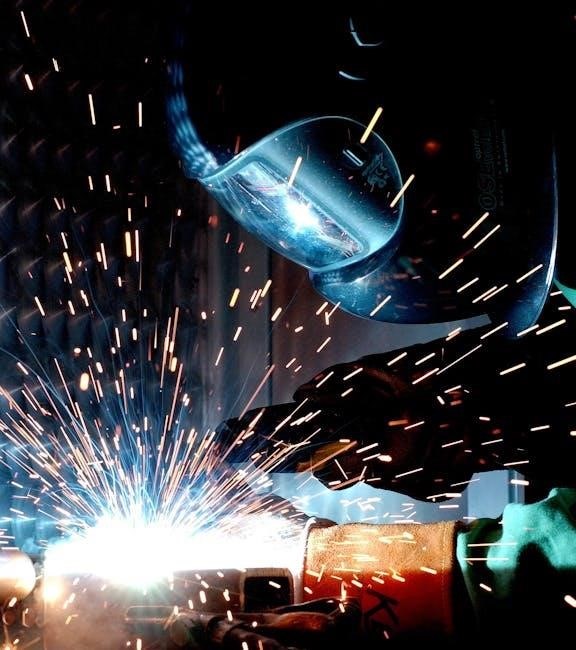Fundamentals of Heat Transfer
The Fundamentals of Heat and Mass Transfer textbook by Incropera, Bergman, and DeWitt provides a comprehensive introduction to heat transfer principles, including conduction, convection, and radiation. It emphasizes a systematic problem-solving approach, making complex concepts accessible while addressing critical energy and environmental issues. The text is widely regarded as a gold standard in heat transfer education, offering detailed explanations, practical examples, and modern applications.
1.1. Conduction
Conduction is the transfer of heat through a material without mass movement, driven by temperature differences. It occurs via atomic vibrations and electron movements. Fourier’s Law of Conduction relates heat flux to the temperature gradient. Materials like metals are excellent conductors due to high thermal conductivity, while insulators like foam have low conductivity. Conduction is fundamental in applications like cookware, electronics, and building insulation.
1.2. Convection
Convection is the transfer of heat through a fluid medium due to its motion. It can occur naturally, driven by buoyancy forces, or be forced by external means like fans or pumps. Heat transfer rates depend on factors such as fluid velocity, turbulence, and temperature gradients. Newton’s Law of Cooling is often applied to calculate convective heat transfer, making it essential in engineering applications like cooling systems and heat exchangers.
1.3. Radiation
Radiation is the transfer of thermal energy through electromagnetic waves, requiring no medium to propagate. It depends on temperature and emissivity of surfaces. Stefan-Boltzmann Law governs radiative heat transfer, with applications in industrial furnaces, space exploration, and solar energy systems. Radiation occurs even in vacuums, making it a critical factor in heat transfer studies, often analyzed alongside conduction and convection for comprehensive thermal management solutions in various engineering fields.

Fundamentals of Mass Transfer
Mass transfer involves the movement of mass due to concentration gradients, driven by diffusion and convection. It is fundamental in chemical engineering and biomedical applications, as detailed in Incropera et al.’s textbook.
2.1. Diffusion
Diffusion is the spontaneous movement of particles from a region of higher concentration to lower concentration, driven by thermal motion. It is a key mechanism in mass transfer, governed by Fick’s Law, which quantifies the flux of particles. Diffusion can occur in gases, liquids, or solids and is essential in processes like food dehydration and drug delivery, as detailed in Incropera et al.’s textbook.
2.2. Convection in Mass Transfer
Convection in mass transfer involves the movement of particles in a fluid due to bulk motion, enhancing diffusion. It occurs naturally or forcibly, influenced by velocity and concentration gradients. This process is crucial in industrial applications like distillation and absorption, as explained in the textbook. Convective mass transfer is often analyzed using boundary layer theories and mass transfer coefficients to predict rates accurately.
Applications of Heat and Mass Transfer
Heat and mass transfer are essential in energy systems, chemical engineering processes, and biomedical applications. They optimize technologies like heat exchangers, distillation, and biomedical devices, enhancing efficiency and innovation across industries.
3.1. Energy Systems
Heat and mass transfer are critical in energy systems, enabling efficient power generation and renewable energy applications. These principles optimize heat exchangers, solar systems, and thermal storage, ensuring minimal energy loss and maximizing performance. Advanced technologies leverage these transfers to enhance energy efficiency and reduce emissions, playing a vital role in sustainable energy solutions and environmental conservation.
3.2. Chemical Engineering Processes
Heat and mass transfer are fundamental to chemical engineering, driving processes like distillation, absorption, and reactor design. These principles ensure efficient separation, mixing, and reaction mechanisms. Advanced heat exchanger designs optimize energy recovery, while mass transfer governs the efficiency of chemical reactions. Understanding these concepts is crucial for developing scalable, safe, and environmentally compliant chemical processes that meet industrial demands and safety standards.
3.3. Biomedical Applications
Heat and mass transfer principles are vital in biomedical engineering, influencing drug delivery, tissue engineering, and medical device design. For instance, understanding diffusion and convection aids in developing controlled-release medications. Thermal management in prosthetics and implants ensures patient comfort and device longevity. These applications rely on precise modeling of transport phenomena to enhance human health outcomes and improve medical technologies.

Key Concepts in Heat and Mass Transfer
The heat transfer coefficient is a critical concept, quantifying the rate of heat exchange between surfaces and fluids, essential for analyzing both heat and mass transfer processes.
4.1. Heat Transfer Coefficient
The heat transfer coefficient (HTC) measures the rate of heat transfer between a surface and a fluid. It depends on factors like fluid velocity, thermal properties, and surface roughness. HTC is crucial in designing heat exchangers and is often determined experimentally or through empirical correlations. Higher HTC values indicate more efficient heat transfer, making it vital for optimizing energy systems and thermal management applications.
4.2. Driving Forces in Transfer Processes
Driving forces in heat and mass transfer are the gradients that initiate the transfer process. For heat transfer, the driving force is the temperature difference between two points. In mass transfer, it is the concentration or chemical potential difference. Understanding these forces is crucial for analyzing and optimizing systems, as they determine the rate and direction of energy and mass flow in various engineering applications.

Mathematical Modeling in Heat and Mass Transfer
Mathematical modeling in heat and mass transfer involves using differential equations and numerical methods to simulate transfer processes, optimizing engineering designs and real-world applications.
5.1. Governing Equations
The governing equations in heat and mass transfer describe the fundamental laws of physics, such as Fourier’s Law for conduction, Newton’s Law of Cooling for convection, and the Stefan-Boltzmann Law for radiation. These equations form the basis for mathematical models, enabling the simulation of complex transfer phenomena in various engineering and scientific applications.
5.2. Numerical Methods
Numerical methods are essential for solving complex heat and mass transfer problems analytically. Techniques like the finite element method and computational fluid dynamics (CFD) enable simulations of real-world scenarios. These methods discretize governing equations into solvable forms, allowing engineers to analyze phenomena like fluid flow and thermal interactions. They are invaluable for optimizing designs and predicting behavior in engineering and scientific applications.
Experimental Techniques
Experimental techniques involve measuring heat transfer coefficients and validating models through real-world applications. Methods like Monte Carlo simulations and finite element analysis support empirical validations and enhance accuracy in heat and mass transfer studies.
6.1. Measurement of Heat Transfer Coefficients
Measuring heat transfer coefficients involves experimental techniques such as surface temperature monitoring and fluid flow analysis. Methods like Monte Carlo simulations and finite element analysis are used to validate theoretical models. These measurements are crucial for understanding convection and radiation effects, ensuring accurate predictions in industrial and engineering applications. Experimental data helps refine models and improve system efficiency in heat exchangers and energy systems.
6.2. Mass Transfer Experiments
Mass transfer experiments focus on measuring diffusion rates and convective transport in various systems. These experiments often involve monitoring concentration gradients and fluid dynamics. Techniques include tracer studies and hydrodynamic analysis to quantify mass flux. Practical applications are seen in chemical engineering, biomedical devices, and environmental systems, where accurate mass transfer modeling is essential for process optimization and efficiency improvements.
Modern Advancements
Modern advancements in heat and mass transfer include computational fluid dynamics (CFD) and nanotechnology applications. These tools enhance modeling accuracy and optimize transfer processes for improved efficiency and sustainability.
7.1. Computational Fluid Dynamics (CFD)
Computational Fluid Dynamics (CFD) has revolutionized heat and mass transfer modeling by enabling detailed simulations of fluid flow and thermal interactions. CFD tools allow engineers to analyze complex systems, optimize designs, and predict performance under varying conditions. This technology is particularly valuable in emerging fields like nanotechnology and biomedical engineering, where precise control of heat and mass transfer is critical for innovation and sustainability. Its applications continue to expand, driving advancements in energy efficiency and environmental solutions.
7.2. Nanotechnology Applications
Nanotechnology leverages heat and mass transfer principles to create innovative materials and systems. Nanostructured materials enhance thermal conductivity, enabling advanced thermal management in electronics and energy systems. Applications include nanoparticles for drug delivery, where controlled mass transfer improves efficacy. These advancements also support green technologies, reducing emissions and improving energy efficiency, making nanotechnology a key driver of modern innovation in heat and mass transfer fields.
Environmental Implications
Heat and mass transfer principles are vital for improving energy efficiency and reducing emissions, addressing environmental challenges through sustainable technologies and emission control strategies effectively.
8.1. Energy Efficiency
Heat and mass transfer principles are essential for enhancing energy efficiency in various systems. By optimizing heat exchanger designs and thermodynamic processes, significant energy savings can be achieved. Advanced materials and technologies, such as those incorporating nanotechnology, further improve efficiency. These innovations reduce energy consumption and emissions, aligning with global sustainability goals and environmental stewardship initiatives in industrial and technological applications.
8.2. Emission Control
Heat and mass transfer principles play a crucial role in emission control technologies. By optimizing heat exchanger designs and mass transfer processes, systems can reduce pollutant emissions. Advanced technologies, such as catalytic converters and electrostatic precipitators, leverage these principles to minimize harmful emissions. Efficient energy systems and industrial processes further contribute to reduced environmental impact, promoting cleaner air quality and sustainability.

Educational Resources
Heat and mass transfer principles are essential for designing emission control systems. Technologies like catalytic converters and electrostatic precipitators rely on these principles to reduce pollutants. Efficient heat exchangers minimize emissions, while mass transfer optimizes filtration processes. These advancements ensure cleaner energy production and industrial operations, significantly reducing environmental impact and promoting sustainable practices;
9.1. Textbooks
Fundamentals of Heat and Mass Transfer by Incropera, Bergman, and DeWitt is a leading textbook in the field, offering a comprehensive introduction to heat and mass transfer principles. Known for its clarity and systematic problem-solving approach, it covers conduction, convection, and radiation, with practical examples and modern applications. Widely used in engineering education, this text is available in multiple editions, including PDF formats, making it accessible for students and professionals alike.
9.2. Online Courses
Online courses on heat and mass transfer are widely available, offering flexible learning opportunities. Platforms like Coursera, edX, and Udemy provide comprehensive courses that cover theoretical foundations and practical applications. These courses often include interactive content, video lectures, and assignments, making them ideal for both undergraduate students and professionals seeking to enhance their knowledge in the field. Many courses also offer downloadable resources, including PDF materials, for offline study.
Industrial Applications
Heat and mass transfer are crucial in industrial processes like heat exchangers, distillation, and energy systems. These principles optimize efficiency, ensuring effective thermal management and material processing across various industries.
10.1. Heat Exchangers
Heat exchangers are essential devices for efficient thermal management, enabling heat transfer between fluids while minimizing energy loss. Common types include shell-and-tube, plate, and fin-tube designs, each optimized for specific applications. They play a critical role in power generation, chemical processing, and HVAC systems, ensuring optimal performance and energy recovery. Proper design and maintenance are vital to maximize efficiency and longevity.
10.2. Distillation and Absorption
Distillation and absorption are critical separation processes in chemical engineering, relying on mass and heat transfer principles. Distillation separates components based on volatility, while absorption involves transferring solutes from gas to liquid. Both processes optimize energy use and efficiency, essential in industrial applications. Design considerations, such as column sizing and solvent selection, ensure effective separation and recovery of valuable compounds, making them indispensable in chemical manufacturing and energy systems.
Research Trends
Current research in heat and mass transfer focuses on advancing computational methods, nanotechnology applications, and sustainable energy solutions. These emerging trends aim to optimize efficiency and address environmental challenges.
11.1. Current Research Topics
Current research in heat and mass transfer explores advancements in computational fluid dynamics (CFD), nanotechnology, and biomedical applications. Studies focus on optimizing energy systems, enhancing thermal management, and improving mass transfer in chemical processes. Emerging topics include radiative heat transfer modeling and sustainable solutions for energy efficiency. These innovations aim to address environmental challenges while advancing industrial and technological applications.
11.2. Future Directions
Future research in heat and mass transfer is expected to focus on sustainable technologies, such as renewable energy systems and advanced materials. Nanotechnology will play a significant role in enhancing thermal management and efficiency. Additionally, interdisciplinary collaborations between engineering and biomedical fields will drive innovations in medical devices and drug delivery systems, ensuring continued progress in both theoretical and practical applications.
Case Studies
Real-world applications of heat and mass transfer principles are explored through case studies on solar energy systems and biomedical devices, demonstrating practical relevance and innovative solutions.
12.1. Solar Energy Systems
Solar energy systems utilize heat transfer principles to convert sunlight into usable energy. Conduction, convection, and radiation are essential in designing efficient solar panels and collectors. Flat-plate collectors and photovoltaic cells demonstrate these principles, enabling applications like water heating and electricity generation. These systems highlight the practical application of heat transfer, contributing to renewable energy solutions and sustainability.
12.2. Biomedical Devices
Biomedical devices rely on heat and mass transfer principles for efficient operation. Applications include drug delivery systems, where diffusion and convection govern drug release, and thermal therapy devices, which manage heat transfer for tumor treatment. Understanding these principles ensures optimal design and functionality, enhancing patient outcomes and advancing medical technology.
The fundamentals of heat and mass transfer are essential for understanding various engineering and scientific applications. This text has explored key concepts, including conduction, convection, and radiation, as well as their role in energy systems, biomedical devices, and environmental sustainability. By mastering these principles, engineers and researchers can develop innovative solutions to global challenges, ensuring efficient and sustainable technologies for future generations.
